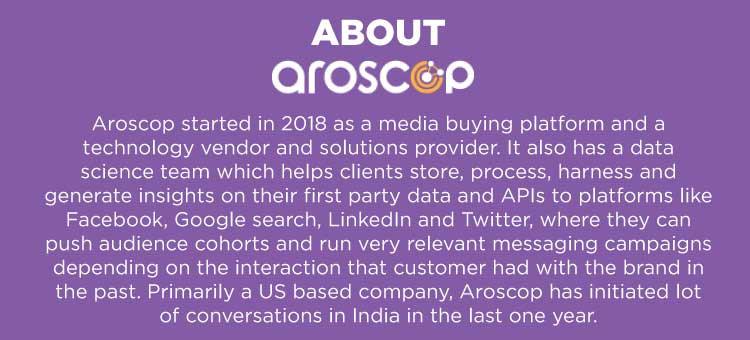Third party cookies are fading away. After Mozilla and Safari, Chrome will also be getting rid of these cookies in the near future. Marketers, media planners and advertisers have relied on these third party cookies for years to control the way their ads are delivered with relevant messages to the desired user (consumer) groups. Aroscop recently released a detailed report titled, ‘The Cookie-less Future: Fears, Opportunities & The Way Forward’.
According to the report, in the absence of third party cookies, ad revenues will take a hit and technology providers will start white labelling technology. However, trust, cohort based tracking and anonymising identity links will help programmatic advertising and the industry be in a better position. Arjun Som, Founding Member, Aroscop explains the report further and shares insights on the changes that the absence of third party cookies will bring in the industry.
Q] Your report mentions about top four advertising strategies that will be affected by fading away of third party cookies – frequency capping, personalisation, behavioural targeting and retargeting. Tell us a bit more about these points and how they will be impacted in a cookie-less world.
Frequency capping is a straightforward strategy of limiting the number of times a consumer sees your ad in a given period of time. The main objective of this strategy is three things – one is to maximise reach, second to reduce ad fatigue and third reason is to reduce spillage. Then comes personalisation. It has two aspects – one is bringing out personalisation of products and services that the user may be interested in, based on their past purchase or browsing data. The second aspect is using programmatic advertising to bring the user back to my website. The objective of personalisation is essentially to increase the propensity of a user to click
on your ad and come to your website and further buy or sign up.
Behaviour targeting is mainly a rule based tagging of users based on consumer behaviour data. Retargeting is essentially finding and saving a user who has previously visited your website based on ‘Dynamic Creative Optimisation’. There is a large overlap between dynamic creative optimisation and personalisation. Across all these aspects there are four main parties that are involved. There is an advertiser, a tech provider, a publisher and a consumer. Now, cookies help in achieving these key strategies as they enable the identification of users across these key stakeholders.
Q] What is the likely shift in existing strategies of brand building that we are likely to see? Could you share some insights on the scenario in terms of the solutions that are available and their preparedness?
The pandemic has created both short term and long term changes in content consumption patterns. And we are seeing about 40-60% of ad spends in favour of branding on digital platforms. If you look at digital as a purely performance based marketing channel, then you’re creating very myopic view of the customer lifecycle. But having said that, one key shift in strategy that we are seeing is a strong understanding of first party data. Every brand is saying that they have these data silos and that they want to understand who their consumer is and which life stage he is at, what controls they have on the touch points. So pivoting on the first party data is how majority of the brands are going to focus going forward.
Q] This shift will also create business challenges for stakeholders. How are they preparing themselves and changing their course on the way?
The cookies and the pandemic have forced a lot of changes among the stakeholders. The main point is to be self-reliant. Stakeholders are collectively deciding on how they become platform, providers and market agnostic. Advertisers will start aggregating data across their data silos and store them. And then this data will be assessed on real time to understand the life stage of their customer. And all other aspects like social search and programmatic will just become a touch point.
In terms of technology providers, we will see data being stored against first party cookie instead of third party. The publishers and advertisers will start demanding this feature in the drive to become platform and provider agnostic. They would want this information to be available against their own identifier rather than third party access.
Agencies will add, or are already adding a technology consulting arm. This will purely advise advertisers on how to navigate the first party data, what technology to use, what are the solutions available, and with the consulting arm, they will also help implement it and use the products.
Role of an agency will broaden. It will not be a purely be a cut in the media spends. It will move into a retainer, technology consulting,
helping the brand harness its first party data, bringing in various products on the market, recommending the right solutions.
Publishers have already started nudging their customers to choose between consent or pay wall. However, publishers do not control their traffic. A lot of publishers receive traffic from social networks like Facebook, Google and YouTube. Secondly, publishers have already started building a compliance framework. They are not waiting for a privacy data protection bill to be announced.
Q] What will the impact on Customer Data Platforms (CDPs) and Programmatic advertising be in a cookie-less world?
The industry is in flux right now and it will see large drops in revenue. We’ve already seen CPMs of Safari and Mozilla browsers drop by about 80%. But with this change (of taking audience consent) we are all forced to build a much stronger foundation. Yes, there will be the revenue impacts, but the foundation for the future will be built on much stronger principles rather than principles which would suddenly be changed in the market. All brands will start setting up CDPs either in-house or with partners or vendors. The advantage is that this will give advertisers, publishers and agencies a variety of products to choose from
at various price points in a cluttered Ad-Tech and MarTech industry.























